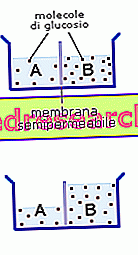Definition of osmosis
Osmosis is the spontaneous passage of a solvent (which in water systems is usually water), from the solution in which the solutes are more diluted to that in which they are more concentrated; this movement - which occurs through a semipermeable membrane - continues until an equilibrium situation is reached, in which both solutions gain and maintain the same concentration.
Practical example

To better clarify the concept of osmosis, let us imagine having a vessel divided into two compartments of equal volume (A and B) from a semipermeable membrane (that is, permeable only to the solvent - in this case the water - and not to the solute). In compartment A there is an aqueous solution in which a tablespoon of glucose was dissolved, while in part B we have an aqueous solution of equal volume in which three tablespoons of glucose were dissolved (it is therefore more concentrated). This difference creates a concentration gradient for glucose on the sides of the membrane and, since this sugar cannot pass through it, the balance is reached with the passage of water from compartment A (where glucose is most diluted) to the compartment B (where it is most abundant). If you prefer, it can also be said that water passes through osmosis from the solution in which it is more concentrated (A) to that in which it is less concentrated (B).
Following this flow, the water level in B increases and decreases in A, creating a certain difference in level between the two. This phenomenon ends when the two solutions reach the same concentration, then keeping it constant.
Hypotonic, isotonic and hypertonic solutions
Taking two solutions with different molar concentrations (different number of particles dissolved in them), the solution with the lowest concentration of molar and hypertonic concentration is defined as hypotonic. Two solutions are instead isotonic (or equimolar) when they have the same concentration.
In the example just given, solution B is hypertonic (therefore it contains more solutes) than the other (defined hypotonic); therefore, under normal conditions, the solvent moves by osmosis from the hypotonic to the hypertonic solution. We talked about standard conditions because, by playing with the laws of physics, it is possible to overturn the very concept of osmosis and favor the passage of the solvent from the most diluted concentration to the most concentrated (reverse osmosis).
Osmotic pressure and reverse osmosis
As expressed so far, the net flow of the solvent - generated by osmosis - continues until the two solutions have reached the same concentration. Well, this movement can be countered, stopped, or even reversed by applying pressure to the compartment with the highest concentration.

In the previous example it is sufficient to place a piston in compartment B (which we recall having a higher concentration), and push it downwards with a certain force, to favor the passage of water towards A; in this case we speak of reverse osmosis.
The osmotic pressure is the pressure that is exactly opposed to the passage of the solvent through the semipermeable membrane; consequently it is the pressure necessary to counter osmosis.
According to what has been said so far, two isotonic solutions boast the same osmotic pressure; to underline, therefore, that the osmotic pressure depends exclusively on the number of particles present in solution and not on their nature.
Osmosis and human body
The plasma membranes that surround the cells of the human body, in fact, are semi-permeable membranes, which allow the direct passage, through osmosis, of small molecules (such as water and urea), but not of those with greater molecular weight (such as proteins, amino acids and sugars). The osmotic balances in body fluids are therefore essential to guarantee the cells an optimal environment in which to live.
If we take a cell like a red blood cell and immerse it in a hypotonic solution, this - by osmosis - undergoes a swelling (given by the entry of water), which can even make it explode. On the contrary, if immersed in a hypertonic solution, the cell suffers, due to the passage of water towards the outside, a severe dehydration that makes it wrinkle. Fortunately, in the human organism the cells are immersed in isotonic solutions with respect to their internal environment, and various systems exist to maintain these liquids in osmotic equilibrium.
Osmotic pressure and food preservation
Let's think for a moment about a homemade jam ... sugar is added in abundance not only to improve its taste, but also and above all to increase its shelf life. Yet, sugar is an important element in the life of many microorganisms involved in product degradation. This apparent contradiction is removed from the very concept of osmosis.




